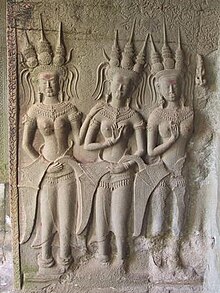
Temple dance denotes a religious performance held in the temples, such as sadir, prescribed by Agamas (scriptures that codified temple rituals, etc.). [1] [2] Traces of these ancient temple dances of India are seen in Bharatanatyam and Odissi. [3]
The sacred Hindu temple dance used to be performed by devadasis and Mahari Dance, who were supposed to manifest in the material body the heavenly dance of apsaras. [1]
References
- ^ a b Younger, Paul; Younger, Professor of Religious Studies Paul (1995). The Home of Dancing Śivan̲: The Traditions of the Hindu Temple in Citamparam. Oxford University Press. ISBN 978-0-19-509532-6.
- ^ Subramuniyaswami, Satguru Sivaya (2003). Dancing with Siva: Hinduism's Contemporary Catechism. Himalayan Academy Publications. ISBN 978-0-945497-89-9.
- ^ Narayan, Shovana (30 December 2011). The Sterling Book of INDIAN CLASSICAL DANCE. Sterling Publishers Pvt. Ltd. ISBN 978-81-207-9078-0.
External links
-
 Media related to
Hindu temple dance at Wikimedia Commons
Media related to
Hindu temple dance at Wikimedia Commons